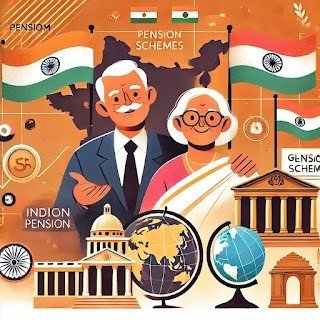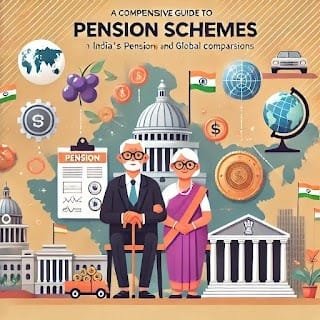Comprehensive Guide to Pension Schemes Worldwide

History of Pension in India, Governing Laws, and the Top 10 Best Pension Schemes Globally
Pension Schemes Worldwide & History of Pension
Introduction: The Importance of Pension Schemes –
Pensions are essential financial tools that provide individuals with a steady income during their retirement years. They act as a safety net, ensuring that people can live comfortably after their working years are over. With increasing life expectancy and rising living costs, the importance of having a reliable pension scheme cannot be overstated. This comprehensive guide will explore the concept of pensions, the history of pension schemes in India, the laws governing them, and a comparison of the top 10 best pension schemes worldwide.
What Is a Pension?
A pension is a financial arrangement where individuals contribute a portion of their earnings into a fund during their working years. Upon retirement, they receive periodic payments from this fund, helping them meet their living expenses without relying solely on savings. Pensions can be employer-sponsored, government-funded, or personally managed, and they come in various forms, including defined benefit plans, defined contribution plans, and public pensions.
The History of Pension in India
Ancient Roots and Colonial Influence – The concept of pensions in India dates back to ancient times, with early references found in the scriptures. However, the modern pension system began during British rule when pensions were introduced for government employees. The first formal pension scheme in India was established in 1881 for civil servants, followed by the introduction of the Provident Fund Act in 1925.
Post-Independence Developments – After India gained independence in 1947, the government expanded pension coverage to include a broader segment of the population. The Employees’ Provident Fund (EPF) was introduced in 1952, providing retirement benefits to salaried employees in the private sector. Over the years, several other pension schemes were launched, including the National Pension System (NPS) in 2004, which opened the door for broader participation across various sectors.
Pension Schemes After 2015 With the introduction of the Atal Pension Yojana (APY) in 2015, the focus shifted towards providing pension coverage for workers in the unorganized sector. The APY offers a guaranteed minimum pension based on contributions and the age at which one joins the scheme. Another recent addition is the Pradhan
Mantri Shram Yogi Maan-Dhan (PM-SYM), launched in 2019, which is a pension scheme for unorganized sector workers like street vendors, mid-day meal workers, and laborers. This scheme ensures a minimum pension of ₹3,000 per month after the age of 60.
For more detailed information on these
schemes, you can visit the official government website:

The Employees’ Provident Fund (EPF) The EPF Act, 1952, is one of the most significant pieces of legislation governing pension schemes in India. It mandates employers and employees to contribute a percentage of the employee’s salary to a retirement fund, which the employee can access upon retirement or under certain conditions.
The Employees’ Pension Scheme (EPS) Introduced in 1995 under the EPF Act, the EPS provides pension benefits to employees in the organized sector. It ensures that employees receive a monthly pension after retiring, provided they meet specific criteria, such as minimum service years.
The National Pension System (NPS) Launched in 2004, the NPS is a voluntary, defined contribution pension system open to all Indian citizens. It allows individuals to invest in a pension account during their working years, with the option to withdraw a portion of the corpus as a lump sum upon retirement and Use the remaining amount to buy an annuity in order to receive regular income.
The Atal Pension Yojana (APY) Introduced in 2015, the Atal Pension Yojana targets unorganized sector workers. It is a government-backed scheme where subscribers receive a guaranteed minimum pension based on their contributions and the age at which they join the scheme.
Top 10 Best Pension Schemes Worldwide
Pension Schemes in Australia – Superannuation Scheme Australia’s Superannuation Scheme is a compulsory pension system where employers must
contribute a percentage of an employee’s salary into a superannuation fund. It is one of the most robust pension systems globally, providing substantial
retirement income.
Pension Schemes in Netherlands – General Old Age Pensions Act (AOW) The Dutch AOW is a public pension scheme funded through taxes, providing a basic pension to all residents over 67. It is complemented by occupational pension schemes, making the Netherlands one of the top countries for retirement security.
Pension Schemes in Denmark – ATP (Labor Market Supplementary Pension) Denmark’s ATP is a mandatory pension scheme that provides a lifelong pension to its members. The scheme is financed through contributions from both employers and employees, ensuring broad coverage and high benefits.
Pension Schemes in Sweden – Pensions System Sweden’s pension system is a mix of public and private schemes. It includes an income-based pension, a premium pension (funded by investments), and an occupational pension. This multi-pillar approach offers comprehensive retirement security.
Pension Schemes in Canada – Canada Pension Plan (CPP) The CPP is a contributory, earnings-related social insurance program. It provides a stable
income to Canadians during retirement, disability, or death, with additional private savings options enhancing the system.
Pension Schemes in Norway – The Norwegian Pension System Norway’s pension system is primarily based on a universal benefit that provides a minimum income to all retirees. It is complemented by occupational pensions and private savings, creating a balanced and secure retirement system.
Pension Schemes in New Zealand – KiwiSaver KiwiSaver is a voluntary, government-supported savings scheme in New Zealand. It encourages
retirement savings through employer and government contributions, offering flexible withdrawal options during retirement.
Pension Schemes in Germany – Statutory Pension Insurance Germany’s statutory pension insurance is a pay-as-you-go system, where current workers’
contributions fund retirees’ pensions. It is one of the most stable systems, providing a reliable income to the elderly.
Pension Schemes in United Kingdom – State Pension The UK State Pension is a contributory pension system providing a regular income to those
who have reached the state pension age. It is supplemented by workplace pensions and personal savings, creating a multi-layered pension system.
Pension Schemes in United States – Social Security The US Social Security system is a government-funded program providing retirement benefits
based on an individual’s earnings history. It is a crucial part of retirement planning for many Americans, supplemented by employer-sponsored 401(k) plans
and personal savings.
Conclusion:
The Need for Informed Pension Planning Pension schemes are essential for securing a comfortable retirement. Understanding the various options available, both in India and globally, can help individuals make informed decisions that align with their financial goals. From the Atal Pension Yojana for unorganized sector workers to the sophisticated systems in countries like Australia and the Netherlands, the world offers a diverse range of pension schemes to explore. By planning early and wisely, you can ensure a stable and fulfilling retirement.
For more details on pension schemes in India, you can visit:
FAQs on Pension Schemes
What is the difference between a pension and a provident fund?
A pension provides regular payments after retirement, while a provident fund is a lump sum benefit received upon retirement or specific conditions.
Can I have more than one pension scheme?
Yes, individuals can participate in multiple pension schemes, such as the NPS and a private pension plan, to diversify their retirement income.
How does the Atal Pension Yojana benefit unorganized sector workers?
The Atal Pension Yojana provides a guaranteed minimum pension to unorganized sector workers who may not have access to formal pension schemes, offering them financial security in their retirement years.
What factors should I consider when choosing a pension scheme?
Consider factors like the scheme’s return on investment, contribution requirements, withdrawal options, and the stability of the scheme provider.
How are pension schemes regulated in India?
Pension schemes in India are regulated by the Pension Fund Regulatory and Development Authority (PFRDA), ensuring that they operate transparently and securely.
You May Also Read:-
Senior Citizens Act Blog
